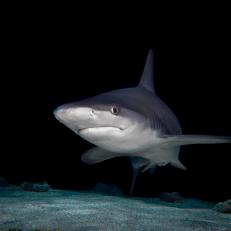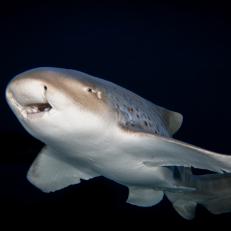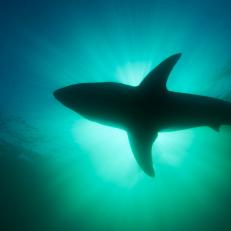Get to Know the Diverse Shark Species of Georgia Aquarium
Did you know there are hundreds of species of sharks? Georgia Aquarium is proud to engage and educate guests to conserve sharks to ensure that they thrive and prosper for future generations. From the small blacktip reef sharks to whale sharks and everything in between, click through to learn about different types of sharks.
Tasseled Wobbegong Shark
It may be surprising, given its unique characteristics, but the tasseled wobbegong is a member of the shark family. A master of escaping notice in plain sight, the tasseled wobbegong is almost undetectable when resting quietly on the bottom. This shark is a great ambush predator, lying motionless on the bottom of the ocean until small fish or other prey move within striking distance, then quickly opens its mouth and sucks in the prey.
Hammerhead Shark
Great hammerhead sharks are an endangered shark species in Georgia Aquarium’s care. An adult great hammerhead shark has no natural predators except humans. This species is largely targeted for its large fins, which are desirable in the fin trade for use in shark fin soup. An important step in helping endangered shark species like this is educating others on the misconception that sharks are highly dangerous to humans, when in fact, humans are the real threat to sharks.
Swell Shark
This unique shark species’ name derives from its ability to swallow large amounts of water, swelling its body to twice its normal size to appear larger when threatened by a predator. This swelling also makes it difficult to dislodge from its crevice or hole. Unfortunately, these sharks are often among the by-catch in commercial fishing nets and traps.
Sandbar Shark
The most abundant shark in the western Atlantic, the sandbar shark is rarely seen at the surface, instead swimming at depths between 60-200 feet. The sandbar shark is an opportunistic feeder, and will consume a variety of prey, including bony fish, smaller sharks, rays, crabs and shrimp.
Zebra Shark
The zebra shark is a docile, considered harmless to humans. It spends most of its day resting on the ocean bottom, becoming more active at night. Zebra shark populations are decreasing due to illegal fishing. Georgia Aquarium has a record of successful reproduction of zebra sharks, giving them the ability to gain a better understanding of this species and how they reproduce, to hopefully one day increase their population numbers in the ocean.
Sand Tiger Shark
Georgia Aquarium cares for several sand tiger sharks and closely studies their behaviors and characteristics to expand knowledge and implement practices to help preserve these sharks in the ocean. Research efforts have included studying their long and interesting reproductive cycle.
Spotted Wobbegong Shark
The spotted wobbegong shark has a distinctive body shape, its head and body are very flattened, and the pectoral and pelvic fins are broad. This animal is a nocturnal ambush predator that uses its spotted pattern, beard of fleshy tassels and elongated fins to blend in perfectly with its surroundings. During the day, this shark appears to favor specific caves to rest in. These caves are often shared with small schooling fishes.
Epaulette Shark
The epaulette is a member of the shark family. Its large dark spots located above its pectoral fins, when seen from above, can be mistaken for eyes of a much larger fish and help protect this shark from predators. This species can survive several hours in tide pools with little or no oxygen. Current research studies are exploring how this unique adaptation may help in the treatment of stroke victims and managing difficult surgeries.
Silvertip Shark
The silvertip shark has large eyes enabling them to see in dark, murky waters. They can see up to 10 times more accurately than humans in clear water. They can also sense vibrations in the water, alerting them to potential prey or threats and they have a strong sense of hearing and smell. They are listed as “Vulnerable” on the IUCN Red List and humans are the largest threat to this species as they are caught and utilized for their high-value fins, meat, skin, teeth, and cartilage.
Whale Shark
Whale sharks are the largest fish in the world and play a large part in our ocean’s ecosystems. Georgia Aquarium protects whale sharks through research and conservation efforts in the field, in the laboratory, and through their unique position as the only aquarium in the Western hemisphere to care for these gentle giants. Researchers study their behavior, diets, life cycle, and so much more by having them at the Aquarium.
Silky Shark
This silky shark is one of the most abundant open-water shark species. This species is listed as “Vulnerable” on the IUCN Red List due to over-fishing, low number of offspring, and a slow growth rate. They are often caught as by-catch in tuna fisheries and for human use. It's estimated that the population has decreased by 85% and continues to decrease.
Tiger Shark
The tiger shark is one of the largest carnivores in the ocean. Diet of the tiger shark is one of the most diverse of any shark, consisting of many species of bony fish, sharks, rays, marine mammals (such as seals and dolphins), marine reptiles (such as turtles and sea snakes), invertebrates (such as crustaceans, cephalopods and jellies) and sea birds. Known to consume almost any type of marine debris that ends up in the ocean.

















.jpg.rend.hgtvcom.231.231.suffix/1658256079221.jpeg)



